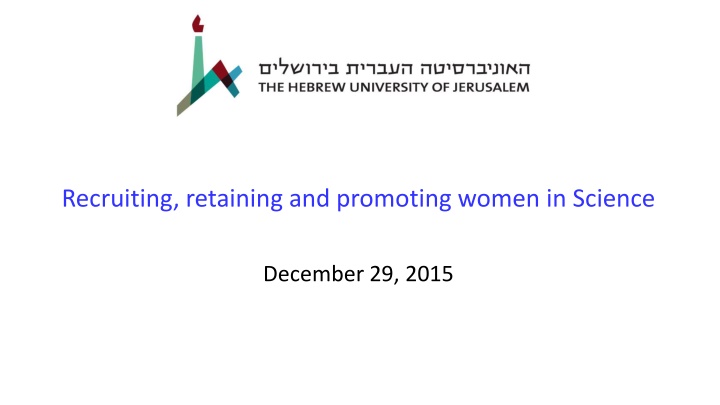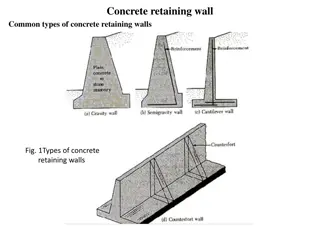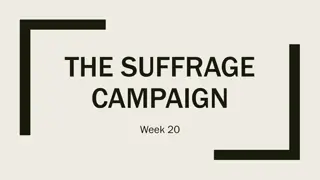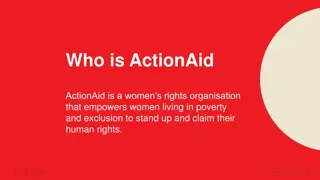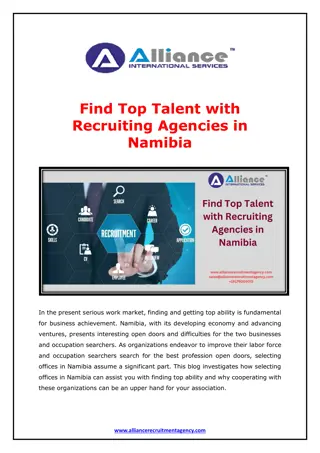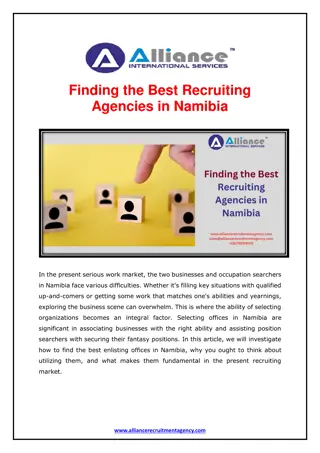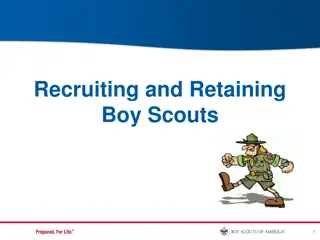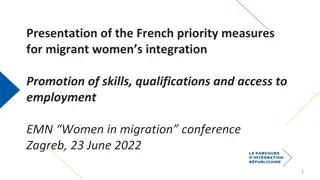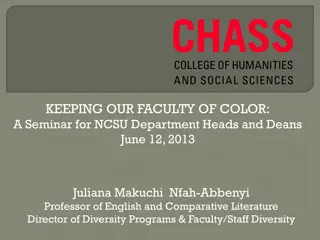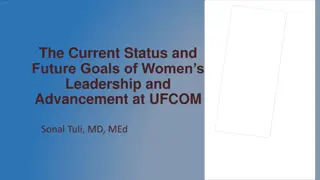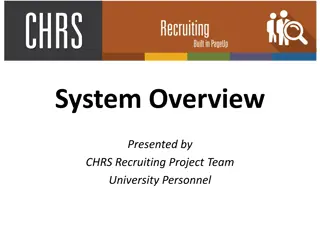Recruiting, Retaining, and Promoting Women in Science - Insights and Challenges
In December 2015, a program at the Hebrew University focused on gender composition among faculty and graduates, highlighting disparities in various academic fields and roles. It discussed efforts and obstacles in recruiting, retaining, and promoting women in science, shedding light on the underrepresentation of female academics. The data revealed patterns of gender distribution in different departments and demonstrated the need for further initiatives to support women in pursuing academic careers.
Download Presentation

Please find below an Image/Link to download the presentation.
The content on the website is provided AS IS for your information and personal use only. It may not be sold, licensed, or shared on other websites without obtaining consent from the author.If you encounter any issues during the download, it is possible that the publisher has removed the file from their server.
You are allowed to download the files provided on this website for personal or commercial use, subject to the condition that they are used lawfully. All files are the property of their respective owners.
The content on the website is provided AS IS for your information and personal use only. It may not be sold, licensed, or shared on other websites without obtaining consent from the author.
E N D
Presentation Transcript
Recruiting, retaining and promoting women in Science December 29, 2015
Program Prof. Menahem Ben-Sasson, President Prof. Batsheva Kerem, President s advisor for promoting women in Science Dr. Yael Levitte, Associate Vice Provost for Faculty Development and Diversity, Cornell. Q & A Prof. Asher Cohen, Rector Meeting with Yael Levitte, for a further discussion
Graduated students 2015 47%in the entire University 56% in the Humanities, social sciences (non-exp) 43%in experimental and exact sciences
Gender Composition of the academic staff at the Hebrew University (2013/2014/2015) 26%in the entire University 34% in the Humanities 18%in experimental and exact sciences (% women)
Gender Composition at the Hebrew University (% women) (2013/2014/2015) Graduated 26%in the entire University (47%) 34% in the Humanities (56%) 18%in experimental and exact sciences (43%) Only a small number of the relatively large number of Ph.D. female students opt for an academic career.
Gender Composition at the Hebrew University (2013/2014/2015) Experimental sciences Humanities 18% are women 34% are women 21% Full Prof. 9% Full Prof. 31% Associate Prof. 22% Associate Prof. 41% Senior Lecturer 20% Senior Lecturer 51% Lecturer 70% Lecturer* 26% in total
New Faculty 2015 17/5730% of the new faculty are women 31% (9/29) of the new faculty in the humanities and social sciences are women. 29% (8/28) of the new faculty in the experimental and exact sciences are women (biology, chemistry, mathematics, pharmacology, etc)
New Faculty in humanities and social sciences 2015 Social Sciences 5/11 (45%) Humanities 1/10 (10%) Law 1/3 (33%) Economics 0/1 (0%) Business School 1/3 (33%) School of Social work 1/1 (100%) ----------------------------------------------------- Total 9/29 (31%)
New Faculty in experimental sciences 2015 Natural Sciences 4/16 (25%) Engineering & computer sciences 2/4 (50%) Medicine 1/4 (25%) Agriculture 2/4 (40%) Brain Sciences 0/1 (0%) School of dentist 1/2 (50%) ---------------------------------------------------------------------- Total 8/28 (29%)
New Faculty in Natural sciences 2015 Physics 0/3 Mathematics 0/3 Chemistry 1/3 Life Sciences 1/3 Computer sciences 2/4 -------------------------------------------- Total 4/16
Gender equity among the academic staff: 50% women recruitments in all university disciplines. 50% women in all committees. 50% women among deans, chairs of schools, etc.
PhD students PhD extension (6 months) following birth, adoption, etc. Mandatory fellowship payment during maternity leave (14 weeks). Mandatory fellowship payment for additional 14 weeks. The 15:30 rule
Why so few women among the staff? Only a small number of the relatively large number of Ph.D. female students opt for an academic career. Post-doc abroad a bottleneck for most women (relocation for 4-5 years). Joining the academic life in the university: Combining family with teaching and research.
Women Fellowships for Post-Doc training abroad Two years ago we launched a Post-Doctorate Fellowship Program for excellent PhD students exclusively for women. The budget is limited 100,000 Australian $ per year (for 5 years). Three more years left . We can fund five one year fellowships for one year in the first year (16,000-21,000 $).
Our mission - 2025 10 post doc fellowships, 25,000$/year, for two years. 0.5 million $ every year
Courses of action Conferences to encourage women to do a post doctorate fellowship abroad: How to choose a Post-Doc position. Presentation of available funding for women. A discussion with female faculty members who joined HU in the last 5 years following Post-Doc training abroad.
Courses of action - female faculty One year extension of the tenure-clock to faculty who gave birth. Reduction of teaching load for women faculty upon return from maternity leave. Gender composition of committees, especially in High-Powered committees. Meetings with female who are not yet tenure in the university
Courses of action - for female students and staff (Dean of Students and his staff) Day-care facilities (nursery schools) - we have one in each of the HU campuses. Special rooms for diapering and nursing - we have one in each of HU campuses. Special women fellowships (B.A post doc). Special programs for students who gave birth during university studies - completing the missing studies (medical students).
Cornell's Model for Recruiting, Retaining and Advancing Women: Progress and Remaining Challenges Dr. Yael Levitte Associate Vice Provost for Faculty Development and Diversity.
